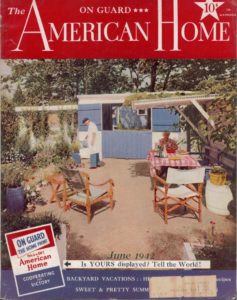Home » Conferences » Kevin Murphy and Alumna Mary Anne Hunting Explore Networks and Archives of the Cambridge School
Kevin Murphy and Alumna Mary Anne Hunting Explore Networks and Archives of the Cambridge School
Posted by vrcvanderbilt on Tuesday, June 25, 2019 in Conferences, Events, HART, Lectures, News, Student/Alumni, Vanderbilt University, VRC.
 Kevin Murphy, department chair and professor of history of art, and Mary Anne Hunting, Vanderbilt alumna (BA’80) and independent scholar, New York City, jointly presented a paper at the annual symposium of The International Archive of Women in Architecture (IAWA) held March 20-22 in the School of Architecture + Design at Virginia Tech. Their talk, “Networks and Archives: The Cambridge School and Beyond,” focused on the personal and professional networks of students, faculty, alumni, and supporters of the Cambridge School of Architecture and Landscape Architecture (1916-1942) in Massachusetts.
Kevin Murphy, department chair and professor of history of art, and Mary Anne Hunting, Vanderbilt alumna (BA’80) and independent scholar, New York City, jointly presented a paper at the annual symposium of The International Archive of Women in Architecture (IAWA) held March 20-22 in the School of Architecture + Design at Virginia Tech. Their talk, “Networks and Archives: The Cambridge School and Beyond,” focused on the personal and professional networks of students, faculty, alumni, and supporters of the Cambridge School of Architecture and Landscape Architecture (1916-1942) in Massachusetts.
This all-women’s architecture school was founded to satisfy the needs of candidates excluded from the all-male Harvard architecture program or unwelcome at the nearby coeducational Massachusetts Institute of Technology. Eventually, the Cambridge School was absorbed by Smith College but was dissolved the moment Harvard accepted women into its architecture program when its enrollment sagged in World War II.
The Cambridge School fomented life-long connections between all who were associated with it. Not only did such faculty members as G. Holmes Perkins find a place in his office for recent graduates, but also the school’s director, Henry Frost, partnered with one of its earliest graduates, Eleanor Raymond. The women also formed networks as they fanned out across the country, working professionally in architecture, landscape architecture, interior design, publishing, merchandising, museums, and other fields.
“Our effort to explore these networks sent us across the country, from Maine and New Hampshire to Montana and California,” said Murphy. “While a few archives are housed in professionally managed institutions, such as the papers of Franziska Porgues Hosken in Harvard’s Frances Loeb Library, the work of most Cambridge School graduates are in the hands of their (now elderly) descendants.”
Murphy and Hunting examined case studies of selected Cambridge School graduates to show that their interconnections can only be understood through their archives, fragile and ephemeral documents of rich professional and personal relationships. Examples include Suzanne Stockard Underwood who transferred from the Cambridge School to Harvard in 1942; her papers are in the surviving home office she shared with her architect husband Julian. Others include Elizabeth-Ann Campbell Knapp, Princeton architect and Montana rancher, with archives now in a family office in Billings; and Ann Halle Little whose work is closely held in Philadelphia by her architect son.
Murphy and Hunting have previously worked together as scholars and architectural historians. Hunting received her doctorate from the City University of New York’s Graduate Center where Murphy was her advisor. Author of Edward Durell Stone: Modernism’s Populist Architect (W. W. Norton & Company, 2012), Hunting presented a lecture entitled “Edward Durell Stone, Modernist Architect: From Vanderbilt to Kennedy Center” as part of Vanderbilt’s Fall 2013 Homecoming events. Last year they jointly presented a paper, “The Professional Couples in Histories of American Modernism,” at the annual international conference of the Society of Architectural Historians.
*Cover of The American Home (June 1942) showing architects and partners Eleanor Raymond and Ethel Power at their summer house in Gloucester, Massachusetts.

©2024 Vanderbilt University ·
Site Development: University Web Communications